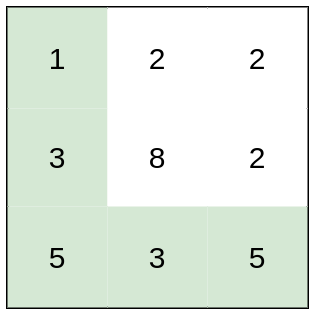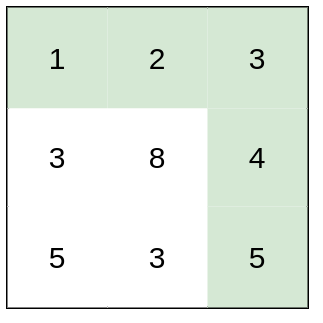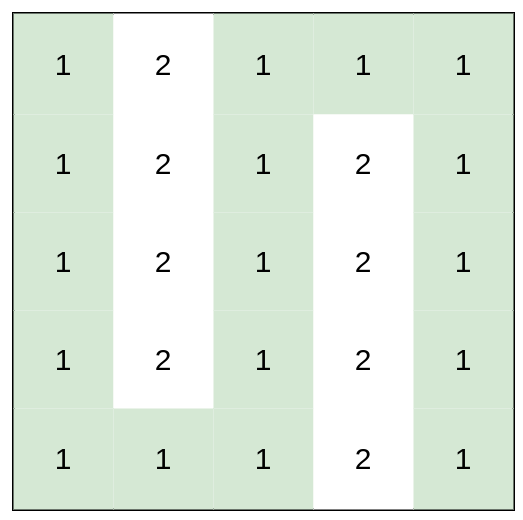Path With Minimum Effort (M)
题目
You are a hiker preparing for an upcoming hike. You are given heights, a 2D array of size rows x columns, where heights[row][col] represents the height of cell (row, col). You are situated in the top-left cell, (0, 0), and you hope to travel to the bottom-right cell, (rows-1, columns-1) (i.e., 0-indexed). You can move up, down, left, or right, and you wish to find a route that requires the minimum effort.
A route's effort is the maximum absolute difference in heights between two consecutive cells of the route.
Return the minimum effort required to travel from the top-left cell to the bottom-right cell.
Example 1:

Input: heights = [[1,2,2],[3,8,2],[5,3,5]]
Output: 2
Explanation: The route of [1,3,5,3,5] has a maximum absolute difference of 2 in consecutive cells.
This is better than the route of [1,2,2,2,5], where the maximum absolute difference is 3.
Example 2:

Input: heights = [[1,2,3],[3,8,4],[5,3,5]]
Output: 1
Explanation: The route of [1,2,3,4,5] has a maximum absolute difference of 1 in consecutive cells, which is better than route [1,3,5,3,5].
Example 3:

Input: heights = [[1,2,1,1,1],[1,2,1,2,1],[1,2,1,2,1],[1,2,1,2,1],[1,1,1,2,1]]
Output: 0
Explanation: This route does not require any effort.
Constraints:
rows == heights.lengthcolumns == heights[i].length1 <= rows, columns <= 1001 <= heights[i][j] <= 10^6
题意
在矩阵中找到一条从左上角到右下角的路径,使得该路径上所有相邻两个元素的差的绝对值的最大值最小。
思路
最短路问题,Dijkstra算法。
代码实现
Java
class Solution {
public int minimumEffortPath(int[][] heights) {
int m = heights.length, n = heights[0].length;
int[][] e = new int[m][n];
Queue<int[]> q = new PriorityQueue<>((a, b) -> a[0] - b[0]);
int[] xShift = {-1, 0, 1, 0}, yShift = {0, 1, 0, -1};
for (int[] tmp : e) {
Arrays.fill(tmp, Integer.MAX_VALUE);
}
e[0][0] = 0;
q.offer(new int[]{0, 0, 0});
while (!q.isEmpty()) {
int[] cur = q.poll();
if (cur[1] == m - 1 && cur[2] == n - 1) {
return cur[0];
}
for (int i = 0; i < 4; i++) {
int nX = cur[1] + xShift[i], nY = cur[2] + yShift[i];
if (nX >= 0 && nX < m && nY >= 0 && nY < n) {
int nE = Math.max(cur[0], Math.abs(heights[nX][nY] - heights[cur[1]][cur[2]]));
if (nE < e[nX][nY]) {
e[nX][nY] = nE;
q.offer(new int[]{nE, nX, nY});
}
}
}
}
return -1;
}
}